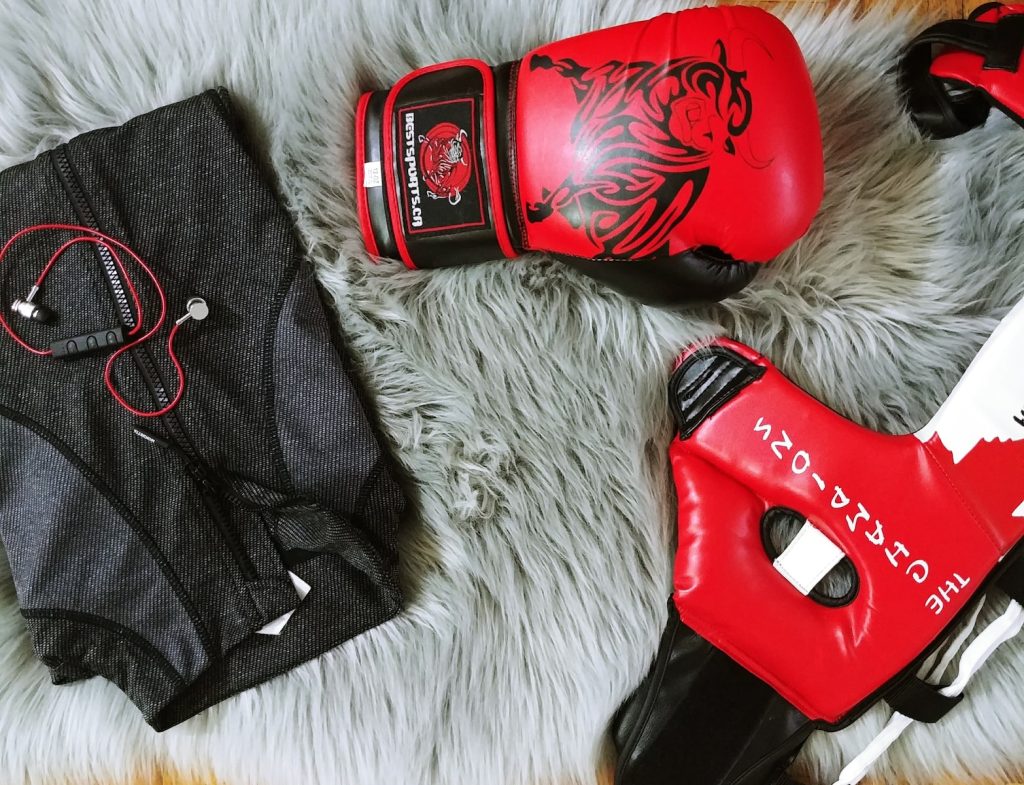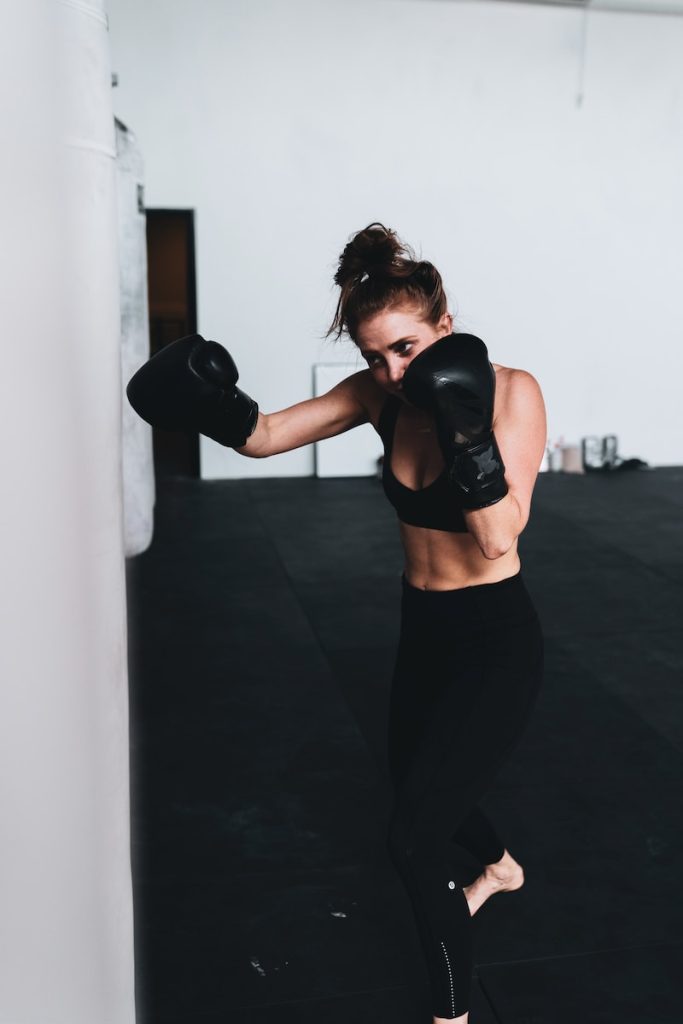Are you tired of the same old boring cardio workouts? Running on a treadmill or pedaling away on a stationary bike can get pretty monotonous after a while. Well, have no fear because kickboxing is here! This high-intensity workout combines martial arts techniques with heart-pumping cardio to give you a full-body workout that will leave you feeling strong and energized. And hey, if anyone ever messes with you, you’ll be ready to throw a punch or two! So put on your gloves, grab a funny water bottle, and let’s get ready to kick some butt (figuratively, of course).
What is Kickboxing?
Kickboxing is a high-intensity workout that combines martial arts techniques with cardiovascular exercise. It originated in Japan and was later developed in the United States as a form of fitness. Kickboxing typically involves punching, kicking, knee strikes, and elbow strikes. These techniques are performed on punching bags or pads held by a partner and can be modified to suit different skill levels and fitness goals.
Aside from its physical benefits, kickboxing is also a great stress reliever and can improve mental clarity and focus. Many people find that it’s a fun way to get their heart pumping and release tension while also building strength and agility.
There are different types of kickboxing, including Muay Thai, which is a form of kickboxing that originated in Thailand and incorporated clinching and knee strikes, and American kickboxing, which focuses more on punches and kicks. No matter which style you choose, kickboxing is a great way to get in shape, feel empowered, and have fun simultaneously.
Benefits of Kickboxing
Kickboxing is a full-body workout that offers a range of physical and mental benefits. Here are some of the top benefits of kickboxing:
- Cardiovascular health: Kickboxing is an excellent cardiovascular workout that can improve heart health and endurance. The high-intensity nature of kickboxing helps to increase your heart rate and get your blood pumping, which can improve circulation and reduce the risk of heart disease.
- Strength training: Kickboxing involves a variety of movements that can help to build muscle and strength in your arms, legs, and core. The kicks and punches require power and force, which can lead to increased muscle mass and improved muscular endurance.
- Stress relief: Kickboxing is a great way to release stress and tension. Physical exertion can help to release endorphins, which are natural mood boosters. Additionally, focusing on the movements and techniques involved in kickboxing can help to take your mind off of any worries or stressors you may be experiencing.
- Improved coordination and balance: The various kicks, punches, and footwork involved in kickboxing can help to improve coordination and balance. Over time, you may notice that your movements become more fluid and precise, which can translate to other areas of your life, such as sports or dance.
- Increased confidence: Kickboxing can help to boost self-confidence and self-esteem. As you become more proficient in the movements and techniques involved in kickboxing, you may feel more empowered and capable in other areas of your life.
Overall, kickboxing is a fun and challenging workout that can offer a range of physical and mental benefits. Whether you’re looking to improve your cardiovascular health, build strength, or relieve stress, kickboxing may be a great option to consider.
Gear and Equipment Needed

If you’re interested in trying out kickboxing, there are a few pieces of gear and equipment that you’ll need to get started. Here’s a list of the essential items:
- Boxing gloves: Boxing gloves are essential for protecting your hands during training. They come in a variety of sizes and weights, so be sure to choose a pair that fits comfortably and provides adequate protection.
- Hand wraps: Hand wraps are thin strips of fabric that are wrapped around your hands and wrists before you put on your gloves. They help to provide extra support and protection for your hands and wrists during training.
- Punching bag: A punching bag is a heavy bag used to practice punches and kicks. They come in various sizes and weights, so be sure to choose one that suits your skill level and fitness goals.
- Kickboxing shoes: While not absolutely necessary, kickboxing shoes can provide additional support and traction during training. Look for lightweight, flexible shoes that provide a good grip on the floor.
- Workout clothes: Wear comfortable, breathable clothing that allows you to move freely. Avoid anything too baggy or loose-fitting, as it can get caught on equipment or inhibit your movements.
- Water bottle: Staying hydrated is important during any workout, so be sure to bring a water bottle with you to stay hydrated throughout your kickboxing session.
Keep in mind that some gyms may provide some of this equipment, but it’s always a good idea to have your own gear if you plan to train regularly. With these basic gear and equipment, you’ll be ready to start your kickboxing journey and reap all the benefits this high-energy workout offers!
Types of Punching Combinations

Punching combinations are a fundamental part of kickboxing, and they allow you to string together multiple punches to create a more powerful attack. Here are some of the most common types of punching combinations in kickboxing:
- Jab-cross: This is the most basic punching combination in kickboxing. It consists of a quick, straight punch with your lead hand (jab), followed by a more powerful, cross-body punch with your backhand (cross). This combination is great for setting up your opponent and finding your range.
- Jab-cross-hook: This combination adds a hook punch to the end of the jab-cross combination. After throwing the cross, pivot on your back foot and swing your lead arm in a circular motion to throw a hook punch. This combination is great for targeting your opponent’s head and body.
- Jab-cross-uppercut: This combination adds an uppercut punch to the end of the jab-cross combination. After throwing the cross, bring your back hand down and up in a circular motion to throw an uppercut punch. This combination is great for targeting your opponent’s chin and body.
- Jab-cross-hook-cross: This combination adds a second cross punch to the end of the jab-cross-hook combination. After throwing the hook punch, bring your arm back to your face and throw another cross punch with your backhand. This combination is great for finishing off a series of punches and ending with a powerful strike.
- Jab-cross-slip-cross: This combination involves slipping to the side to avoid your opponent’s punch, followed by a cross punch. After throwing the cross punch, slip to the other side to avoid another punch from your opponent, and finish with another cross punch. This combination is great for counterattacking your opponent and avoiding their strikes.
These are just a few examples of the many punching combinations that you can use in kickboxing. Practice these combinations with a partner or on a punching bag to improve your technique and add more power and variety to your strikes.
Warm Up Exercises
Before you jump into your kickboxing routine, it’s important to properly warm up your body. A good warm-up will help to increase blood flow to your muscles, loosen up your joints, and prepare your body for the physical demands of the workout ahead. Here are a few warm-up exercises you can try before your kickboxing session:
- Jumping jacks: Jumping jacks are a great way to get your heart rate up and get your blood pumping. Start with a few sets of 10-20 jumping jacks to warm up your body.
- High knees: Stand in place and bring your knees up to your chest, one at a time. Alternate legs and try to bring your knees up as high as possible. This will help warm up your hip flexors and move your body.
- Butt kicks: Stand in place and bring your heels up to your glutes, one at a time. Alternate legs and try to kick your heels up as high as possible. This will help warm your hamstrings and increase your heart rate.
- Shadowboxing: Shadowboxing is a great way to warm up your muscles and practice your technique simultaneously. Stand in front of a mirror and throw punches and kicks in the air, focusing on your form and technique.
- Stretching: After doing some light cardio and shadowboxing, stretching your muscles to prevent injury is important. Focus on stretching your hamstrings, quadriceps, calves, shoulders, and back.
Remember to take your time with your warm-up and listen to your body. If something feels uncomfortable or painful, stop and modify the exercise. By properly warming up your body, you’ll be ready to tackle your kickboxing routine and get the most out of your workout!
Cool Down and Stretching
After an intense kickboxing workout, it’s important to properly cool down and stretch your muscles to prevent injury and reduce soreness. Here are some cool-down and stretching exercises you can try after your kickboxing session:
- Cool down: After your workout, take a few minutes to walk or jog slowly to decrease your heart rate and cool down your body gradually.
- Shoulder stretch: Stand with your feet hip-width apart and raise one arm above your head. Bend your elbow so that your hand reaches down your back, and use your other hand to gently pull your elbow towards the opposite side. Hold for 10-15 seconds, then switch sides.
- Quad stretch: Stand with your feet hip-width apart and bend one knee to bring your heel towards your glutes. Hold onto your ankle with your hand and gently pull your heel towards your butt. Hold for 10-15 seconds, then switch sides.
- Hamstring stretch: Sit on the ground with your legs straight out in front of you. Reach forward with both hands towards your toes, keeping your back straight. Hold for 10-15 seconds.
- Butterfly stretch: Sit on the ground with the soles of your feet touching and your knees bent out to the sides. Hold onto your ankles and gently press your knees down towards the ground. Hold for 10-15 seconds.
Remember to stretch slowly and gently, and never force your body into an uncomfortable or painful position. Properly cooling down and stretching after your kickboxing workout will help your muscles recover and reduce the risk of injury or soreness.
Conclusion: Reap the Rewards
In conclusion, kickboxing is an excellent way to get a full-body workout while having fun and learning new skills. By incorporating kickboxing into your fitness routine, you can improve your cardiovascular health, increase your strength and flexibility, and reduce stress. With the right gear and equipment, warm-up exercises, punching combinations, and cool-down and stretching exercises, you can reap the rewards of kickboxing and feel like a champ.
So what are you waiting for? Get ready to kick some serious butt and become a kickboxing master!






























